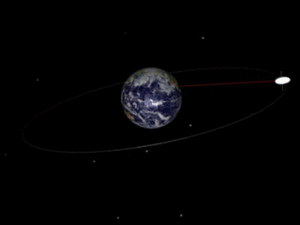What does geosynchronous orbit mean?
Definitions for geosynchronous orbit
geosyn·chronous or·bit
This dictionary definitions page includes all the possible meanings, example usage and translations of the word geosynchronous orbit.
Princeton's WordNet
geosynchronous orbitnoun
a circular orbit around the Earth having a period of 24 hours
Wikipedia
Geosynchronous orbit
A geosynchronous orbit (sometimes abbreviated GSO) is an Earth-centered orbit with an orbital period that matches Earth's rotation on its axis, 23 hours, 56 minutes, and 4 seconds (one sidereal day). The synchronization of rotation and orbital period means that, for an observer on Earth's surface, an object in geosynchronous orbit returns to exactly the same position in the sky after a period of one sidereal day. Over the course of a day, the object's position in the sky may remain still or trace out a path, typically in a figure-8 form, whose precise characteristics depend on the orbit's inclination and eccentricity. A circular geosynchronous orbit has a constant altitude of 35,786 km (22,236 mi).A special case of geosynchronous orbit is the geostationary orbit, which is a circular geosynchronous orbit in Earth's equatorial plane with both inclination and eccentricity equal to 0. A satellite in a geostationary orbit remains in the same position in the sky to observers on the surface.Communications satellites are often given geostationary or close to geostationary orbits so that the satellite antennas that communicate with them do not have to move, but can be pointed permanently at the fixed location in the sky where the satellite appears.
ChatGPT
geosynchronous orbit
A geosynchronous orbit is a high Earth orbit that allows satellites to match Earth's rotation. Located at 22,236 miles (35,786 kilometers) above Earth's equator, this orbit allows a satellite to stay fixed over one longitude, appearing stationary relative to the rotating Earth. The satellites following this orbit are known as geosynchronous satellites. They complete one full orbit in 24 hours, thus, synchronizing with the Earth's rotation.
Wikidata
Geosynchronous orbit
A geosynchronous orbit is an orbit around the Earth with an orbital period of one sidereal day, matching the Earth's sidereal rotation period. The synchronization of rotation and orbital period means that, for an observer on the surface of the Earth, an object in geosynchronous orbit returns to exactly the same position in the sky after a period of one sidereal day. Over the course of a day, the object's position in the sky traces out a path, typically in the form of an analemma, whose precise characteristics depend on the orbit's inclination and eccentricity. A special case of geosynchronous orbit is the geostationary orbit. Popularly, the term "geosynchronous" may be used to mean geostationary. Specifically, geosynchronous earth orbit may be a synonym for geostationary earth orbit. Geostationary orbit is a circular geosynchronous orbit at zero inclination, that is, directly above the equator. A satellite in a geostationary orbit appears stationary, always at the same point in the sky, to ground observers. Communications satellites are often given geostationary orbits, or close to geostationary, so that the satellite antennas that communicate with them do not have to move, but can be pointed permanently at the fixed location in the sky where the satellite appears.
Matched Categories
Numerology
Chaldean Numerology
The numerical value of geosynchronous orbit in Chaldean Numerology is: 6
Pythagorean Numerology
The numerical value of geosynchronous orbit in Pythagorean Numerology is: 1
Translations for geosynchronous orbit
From our Multilingual Translation Dictionary
- วงโคจร geosynchronousThai
Get even more translations for geosynchronous orbit »
Translation
Find a translation for the geosynchronous orbit definition in other languages:
Select another language:
- - Select -
- 简体中文 (Chinese - Simplified)
- 繁體中文 (Chinese - Traditional)
- Español (Spanish)
- Esperanto (Esperanto)
- 日本語 (Japanese)
- Português (Portuguese)
- Deutsch (German)
- العربية (Arabic)
- Français (French)
- Русский (Russian)
- ಕನ್ನಡ (Kannada)
- 한국어 (Korean)
- עברית (Hebrew)
- Gaeilge (Irish)
- Українська (Ukrainian)
- اردو (Urdu)
- Magyar (Hungarian)
- मानक हिन्दी (Hindi)
- Indonesia (Indonesian)
- Italiano (Italian)
- தமிழ் (Tamil)
- Türkçe (Turkish)
- తెలుగు (Telugu)
- ภาษาไทย (Thai)
- Tiếng Việt (Vietnamese)
- Čeština (Czech)
- Polski (Polish)
- Bahasa Indonesia (Indonesian)
- Românește (Romanian)
- Nederlands (Dutch)
- Ελληνικά (Greek)
- Latinum (Latin)
- Svenska (Swedish)
- Dansk (Danish)
- Suomi (Finnish)
- فارسی (Persian)
- ייִדיש (Yiddish)
- հայերեն (Armenian)
- Norsk (Norwegian)
- English (English)
Word of the Day
Would you like us to send you a FREE new word definition delivered to your inbox daily?
Citation
Use the citation below to add this definition to your bibliography:
Style:MLAChicagoAPA
"geosynchronous orbit." Definitions.net. STANDS4 LLC, 2024. Web. 28 May 2024. <https://www.definitions.net/definition/geosynchronous+orbit>.



Discuss these geosynchronous orbit definitions with the community:
Report Comment
We're doing our best to make sure our content is useful, accurate and safe.
If by any chance you spot an inappropriate comment while navigating through our website please use this form to let us know, and we'll take care of it shortly.
Attachment
You need to be logged in to favorite.
Log In